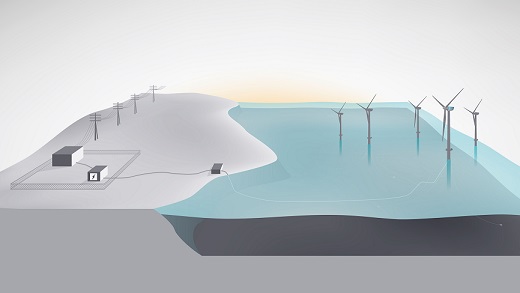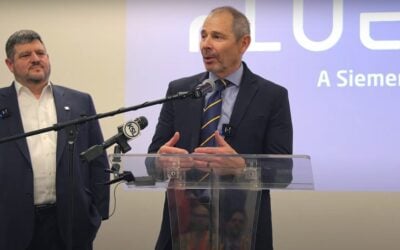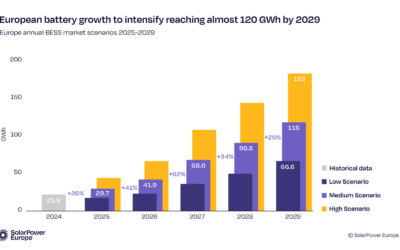
Giants of the UK energy sector are to work within a new collaborative group aimed at enabling significant cost reductions for the electricity system through the use of energy storage applications.
The Energy Systems Innovation Platform (ESIP) has been unveiled today by emissions reduction advisory group, the Carbon Trust and brings together utilities Centrica, DONG Energy, SSE, Scottish Power, Statoil and Wood Group’s Clean Energy division.
Enjoy 12 months of exclusive analysis
- Regular insight and analysis of the industry’s biggest developments
- In-depth interviews with the industry’s leading figures
- Annual digital subscription to the PV Tech Power journal
- Discounts on Solar Media’s portfolio of events, in-person and virtual
The companies will work together to solve what they see as “key issues” currently preventing a more cost effective transition to a low carbon energy system by developing new business models.
Andrew Lever, director of innovation at the Carbon Trust, said: “There is now general consensus that the UK energy market needs to be revamped so we can embrace a flexible and more decentralised energy system. However, the fragmented nature of the energy market is driving fragmented decision making and many investments are led by technology, not market needs.
“We now have a window of opportunity to foster new business models and put in place the regulatory mechanisms that will give investors the confidence to stop chasing market distortions and focus on the long term.
“The formation of ESIP is indicative that no one organisation can solve this issue alone and a collaborative approach is essential to deliver the biggest benefit to society as a whole.”
Representing almost half of the UK’s electricity supply market and with initial support from the Scottish government and the Foreign and Commonwealth Office (FCO), the initiative will tackle regulatory barriers which many believe have held back the development of UK storage.
It will also seek greater transparency around the decision making made across the UK energy system concerning the services storage can provide. According to Lever, this includes the choices made across DNOs, Ofgem, National Grid and government which he said “needs to be joined up and transparent to ensure the right direction, rules and signals are given to the market”.
It is hoped this will help ESIP develop the long term business models necessary to encourage stronger investment and reach the potential of greater flexibility in the UK energy system.
Last year the Carbon Trust led a study which found that the UK could be saving up to £2.4 billion (US$3.05 billion) every year by 2030 if flexibility solutions such as energy storage were integrated into the UK electricity system.
Nils Lehmann, ESIP project manager at the Carbon Trust, said: “ESIP’s focus on developing viable business models for storage use cases aligned with system benefits is a vital piece of the puzzle which has not been looked at yet.
“ESIP works in an evidence-based way to address market failures while simultaneously identifying commercial opportunities for industry. This can help to overcome the ‘chicken and egg’ dilemma between market creation and industry deployment that often limits the uptake of promising new solutions.”
Carbon Trust says each partner brings experience from across the UK energy system, with ESIP taking an “impartial and technology neutral” perspective on opportunities for energy storage to provide flexibility.
However, it will begin its work on integration of wind energy using energy storage, as each member is said to have an immediate interest in this area. For example, DONG Energy is currently preparing to add a 2MW battery storage system into the Burbo Bank offshore wind farm to deliver frequency response.
Carbon Trust says the group is meeting an urgent need for an open forum where the wider industry can collaborate on energy storage.
In depth approach
Currently, similar work is being undertaken by National Grid’s Power Responsive Steering Group, which includes Centrica and DONG as well as a number of other DNOs and private firms, which was set up as a collaborative programme between business customers and the energy market to increase participation in demand side flexibility.
However, Lever told Clean Energy News that ESIP’s work would take a more in depth approach than National Grid’s current working group.
“We are a small group of seven versus [the] Power Responsive group of 100+, which means we can go into greater depth of analysis and take a broader systems view beyond the system operator’s scope. The group is also technology neutral and coming from the perspective of focusing on ‘how storage can bring down the cost [of] renewables’ instead of creating a market for storage,” he said.
The group will publish the key results of its work by the end of the year before deciding its next focus, which Lever said would be driven collectively by the group and may include “broader flexibility applications” across domestic, community, and commercial and industrial scale applications.
In the meantime, ESIP is open to other members who share the strategic objective of “taking a systems view when considering flexible solutions to bring down the cost of the future energy system”.






